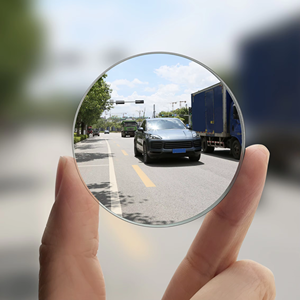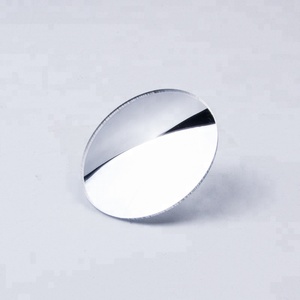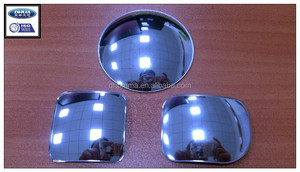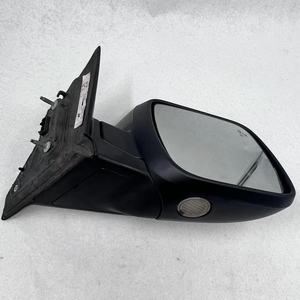(3258 products available)




















































































































































































































Blind spot view side mirrors are safety features in vehicles that help drivers avoid accidents when changing lanes or merging into traffic. Depending on their design and functionality, blind spot view side mirrors come in various types.
Convex Blind Spot Mirrors
Convex blind spot mirrors are the most commonly used type. They have a curved reflective surface that provides a wider field of view than traditional flat mirrors. The curve allows drivers to see more of their blind spots without significantly altering the mirror's position. Convex mirrors are usually mounted on the existing side mirrors or integrated into the housing for improved visibility.
Electrochromatic Mirrors
Electrochromatic mirrors are advanced technology mirrors that automatically adjust their tint based on the surrounding light conditions. These mirrors reduce glare from the sun or headlights of the vehicles behind. While they primarily serve this purpose, electrochromatic mirrors also include blind spot detection features, enhancing overall safety in various lighting situations.
Camera-Based Systems
Some modern vehicles utilize camera-based systems for blind spot detection. Cameras are integrated into the side mirrors or the vehicle's body, providing a comprehensive view of the blind spot area. When changing lanes, the driver can activate the system, and a display screen shows the blind spot view, allowing for informed decision-making. These systems often include additional features like obstacle detection and rearview integration.
Integrated Sensors
Integrated sensors in blind spot view side mirrors are designed to enhance safety. These mirrors have sensors that monitor the vehicle's blind spots. If another vehicle enters the blind spot area, the sensor triggers a visual indicator on the mirror surface or an audible alert in the cabin. This technology helps prevent lane changes into oncoming traffic, reducing the risk of collisions.
Adaptive Side Mirrors
Some premium vehicles offer adaptive side mirrors as part of the overall vehicle control system. These mirrors can automatically adjust their angle and position based on the vehicle's speed, steering input, and other parameters. The mirrors cover the entire blind spot area at low speeds, providing a wider field of view when changing lanes at higher speeds.
The specifications of the blind spot view mirror will determine how well it works and the safety it provides. Here are some of the things to look out for when getting these mirrors.
Size
The blind spot mirror size will impact its effectiveness. A bigger mirror will give a wider and more comprehensive view. However, it may also obstruct the view of the regular side mirror. The ideal size strikes a balance between visibility and side mirror space.
Shape
Convex blind spot mirrors come in various shapes. A circular shape is the most common. It offers a uniform view in all directions. Other shapes like triangular or rectangular ones may better fit specific mirror sizes.
Material
Glass is the best material for blind spot mirrors. It provides a clear and distortion-free view. Some mirrors use plastic, which may be less durable over time.
Adhesive
The adhesive used to attach the blind spot mirror is vital for its longevity. A strong and weather-resistant adhesive will ensure the mirror stays in place, even in harsh conditions. Some mirrors come with pre-attached adhesive, while others require separate purchase.
Adjustability
Some blind spot mirrors are adjustable after installation. This feature allows drivers to angle the mirror for the best view. Fixed mirrors offer a more straightforward installation process but may provide a one-angle view.
Shatterproof
For safety purposes, some blind spot mirrors are shatterproof. These mirrors use special glass coatings that prevent sharp shards from flying if the mirror breaks. Shatterproof mirrors provide added protection for passengers and pedestrians.
The specifications above are important, but it is also necessary to maintain the blind spot view side mirrors to ensure they serve the purpose for as long as possible. Here are some maintenance tips:
When buying car blind spot mirrors for resale or retail business, consider the type, material, and shape.
Type
There are two main types of blind spot view side mirrors. The first type is the adhesive type, commonly known as stick-on mirrors. These mirrors have a backing layer with adhesive that allows them to stick onto the existing side mirrors. They are easy to install and affordable. The second type is the encapsulated type. These mirrors are placed inside the side mirror housing. They are more expensive and offer better protection to the mirror glass. When choosing which type to buy, consider the target customers and their preferences.
Material
The blind spot side mirrors are made of glass, plastic, or metal. Glass is the most preferred material since it offers a clear view. It has a polished surface that reflects images clearly without distortion. Some glasses have a blue tint that protects users' eyes from glare. Tinted glasses are suitable for customers living in sunny regions. Plastic is shatterproof, making it a safer option for children and passengers. Plastic mirrors are also wrapped in chrome, offering a stylish finish.
Shape
Blind spot mirrors come in different shapes—round, square, and triangular. The choice of shape depends on personal preferences. Some vehicles have rounded side mirrors, so a round blind spot mirror will fit better. The shape also affects the visibility area. Convex and curved shapes offer a wider viewing angle.
Many vehicles come with side mirrors that already have a blind spot feature. For cars without this feature, the blind spot mirrors can be easily installed by following the instructions below. The installation process is quite easy and can be done at home. Before installation, it is important to ensure that the mirrors are compatible with the vehicle. This can be done by checking the shape and size of the existing side mirrors.
To install blind spot view side mirrors, the following steps should be followed:
Some blind spot side mirrors are designed to automatically adjust the mirror angle. These mirrors are usually more expensive and have a more complicated installation process. For mirrors that automatically adjust the angle:
It is important to regularly check the blind spot mirrors to ensure they are properly aligned. Adjust them as necessary to avoid accidents.
Q1: Are heated blind spot mirrors available?
A1: Yes, heated blind-spot mirrors are available. They are particularly useful in cold climates where ice and fog can obstruct visibility. These mirrors use a heating element to dissipate moisture, ensuring a clear view.
Q2: What materials are used to construct blind-spot mirrors?
A2: Blind spot mirrors are often made of glass, which is similar to conventional mirrors. However, certain plastics may be used for the mirror housing or the film itself. It’s important that the materials used are weather resistant and durable.
Q3: Can blind spot mirrors be installed on motorcycles?
A3: Yes, blind-spot mirrors can be installed on motorcycles. The installation process is similar to that of cars. They can be attached to existing side mirrors, providing additional visibility and safety for motorcyclists.
Q4: Do blind spot mirrors require maintenance?
A4: Blind spot mirrors do not require much maintenance. However, users should clean them regularly to maintain visibility. In addition, drivers should periodically check their alignment and adjust them as necessary.
Q5: Can blind spot mirrors be installed on vehicles without side mirrors?
A5: Blind spot mirrors can be installed on vehicles that do not have side mirrors. They can be mounted on the windows or the vehicle's body, providing additional visibility. However, installing them on side mirrors is more effective.